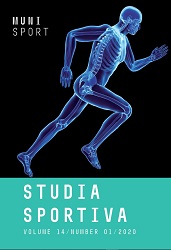Might Salivary Lysozyme Be An Indicator Of Prolonged Intense Training Load In Athletes? A Preliminary Study In Adolescent Male Gymnasts
Might Salivary Lysozyme Be An Indicator Of Prolonged Intense Training Load In Athletes? A Preliminary Study In Adolescent Male Gymnasts
Author(s): Petr Váňa, Jana Juříková, Martina Bernaciková, Radek Ševčík, Alena Žákovská, Petr HedbávnýSubject(s): Sports Studies
Published by: Masarykova univerzita nakladatelství
Keywords: lysozyme; saliva; athletes; gymnasts; training load; overtraining
Summary/Abstract: Lysozyme is one of the salivary antimicrobial proteins (AMP) which act as a defence at the mucosal surface. While in adult athletes, a decrease in salivary lysozyme (SLys) levels has been reported after prolonged intense training, to our knowledge, no studies have been conducted to study the relationship between SLys levels and long-term physical activity in children or teenagers.The aim of this preliminary study was mainly to evaluate in a group of adolescent male gymnasts undergoing prolonged intense training load whether - in accordance with studies in adult athletes - there will also be a decrease in SLys and if so, whether this phenomenon will be so common that we detect it in a small group of study participants.Twelve adolescent male gymnasts aged from 15.0 ± 1.6 years of national or international performance level were recruited to participate in this study. All participants of the study had their sample of saliva taken: I. Period) after the transitional period (rest), i.e. just before the beginning of the preparatory training period. II. Period) immediately after the end of the preparatory training period that was focused on maximal strength and power development. Preparatory training period lasting 6 weeks consisted of nine 2.5 hour training units (on average) over 6 days in every week. At the same time, three times per week two-a-day training sessions were incorporated. Intensity of the physical exercise was not determined.We found a significant decrease in SLys levels after the preparatory training period (termed as II. period) compared to its level just before the start of the training (i.e. after the rest, termed as I. period).The results of this preliminary study suggest that SLys measurements may be an indicator of prolonged training load in adolescent athletes. Although the intensity of the training load has not been determined, the national and international performance level of the gymnasts enrolled in the study allows at least a rough estimate of its level. However, with respect to some limitations of our study, larger studies on male and female adolescent athletes, applying relevant training load with monitoring of variables such as specific sports performance, physical fitness, nutrition, sleep quality, social and psychological factors, are desirable.
Journal: Studia sportiva
- Issue Year: 14/2020
- Issue No: 1
- Page Range: 33-39
- Page Count: 7
- Language: English

